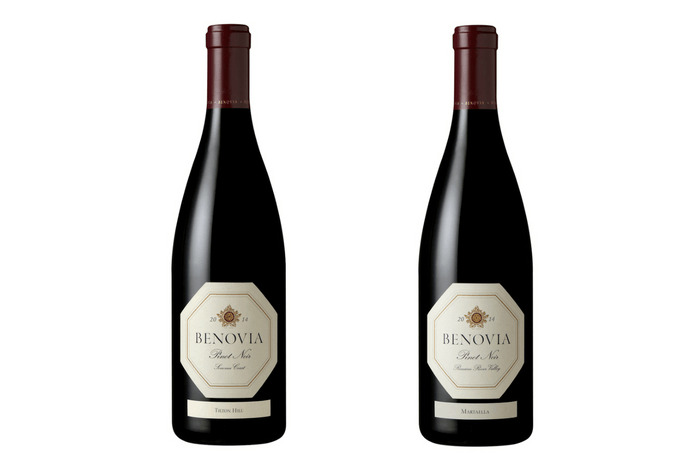Sonoma County's Benovia Winery Makes Definitive Russian River Valley Pinot Noir
Husband and wife Joe Anderson and Mary Dewane, successful health care executives, fell in love with Sonoma County while riding bikes through the area. In 2002, they bought the Cohn Vineyard, one of the oldest pinot noir plantings in California — and in 2005 acquired the DeLoach Vineyards' old Hartman Lane Winery. It was to become Benovia Winery, named in honor of their respective fathers, Novian Anderson and Ben Dewane.
From day one, their objective was to create expressions of pinot noir that reflected the terroir that they came from. To that end they have assembled a collection of three estate pinot noir vineyards: Cohn, Martaella, and Tilton Hill, as well as making a purchased-fruit wine pinot and a chardonnay: La Pommeraie. (As the winery name joins the first names of the couple's fathers, Martaella pays tribute to their mothers — Martha and Eleanor, respectively.) In addition, Benovia bottles a Russian River Valley blend which they call their appellation wine. They also make serious chardonnay and zinfandel.
On a recent visit to Dallas, Anderson, Dewane, and their winemaker/partner Mike Sullivan tasted me on several of their wines.
Russian River Valley Pinot Noir 2014 ($38). This is a blend of all the winery's single-vineyard sites in the Russian River Valley, with no purchased fruit used. It is the least angular of all the Benovia wines, forward, fruity, and ripe. The nose offers raspberries, thyme, and black pepper in an outward rush. The soft, lush fruit in the mouth confirms the fruit in the nose. The soft flavors carry through to the long finish.
Tilton Hill Sonoma Coast Pinot Noir 2014 ($60). Situated on a ridge a few miles from the Pacific Ocean near the town of Freestone, this is the coldest of Benovia's estate vineyards. The 2014 was produced in the third year of drought conditions, with just enough spring rain for the vines to thrive. The harvest was the earliest on record.
Sullivan cold-soaked the must for eight days, followed by an indigenous-yeast fermentation that lasted nearly two weeks. Aging was in 45 percent new French oak. The wine is a translucent ruby red in the glass. A nose of bright cherry is confirmed by the flavors. In the mouth it is also distinctly peppery. This is a loosely structured pinot noir that tastes more mature than its vintage would suggest.
Martaella Vineyard Russian River Valley 2014 ($60). For this release, only heirloom pinot noir clones are used. The exact selection varies each year, but in 2014 these were the Swan, Mt. Eden, Calera, and Pommard clones. Night harvesting (for cool fruit) was followed by hand-sorting and whole-cluster fermentation of a quarter of the grapes. An eight-day cold soak was followed by a fermentation that took almost two weeks. Aging was in 36 percent new French oak. This is another translucent red wine, with a full-on, bright cranberry nose modulated with the raspberry and tomato fruit notes more common to the region's pinot noirs. In the mouth, the texture is juicy, with velvety tannins, and the flavors are intensely fruity, with hints of thyme. Drink this now or within the next year.
Bella Una Russian River Valley 2014 ($80). Not a single-vineyard wine but a blend created by Sullivan from the winery's best lots to express the best of the vintage — "Similar to a reserve wine," he says. Like the Russian River Valley blend above, this wine embodies multiple single-vineyard characteristics, but as a blend of the best of the vintage is more refined, more intense and, frankly, more stylish.
I asked Sullivan for his thoughts on how well the Benovia wines would age. He replied, "The Cohn Vineyard is the wine that we have made consistently since 2006, and in a recent vertical the unanimous favorite was the 2006 Cohn Vineyard Pinot Noir — so I feel the wines are aging quite well and would say that the Benovia pinot noirs can age gracefully for 10 years."
In the pantheon of pinot noir styles the most distinctive are those of Burgundy, Oregon, and Russian River Valley. This tasting showed that Mike Sullivan is doing first-class work in the last of these genres. These wines are fruit-forward, with big, gushing fruit aromas and flavors. The tannins are sweet and velvety. Like all the best Russian River Valley pinots, they have a subtle and complex undertone of herbs and spices that makes them add up to complex, delightful, and collectable examples of this enigmatic grape.

